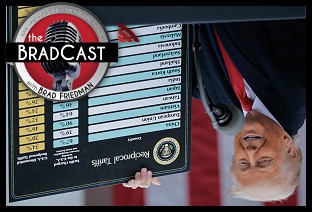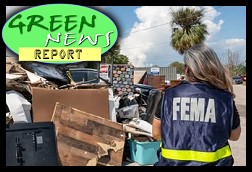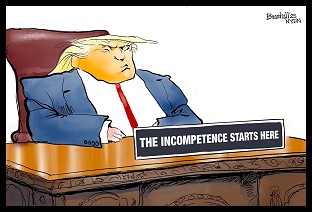Guest Blogged By John Gideon
Election Science Institute (ESI) of San Francisco, California was paid $341,000 by Cuyahoga Co., OH to investigate why the county had so many problems with their voting system in the May 2006 election. Were the problems really all human or were the machines at fault? ESI finally issued a report last week that had plenty of blame to go around between poll worker training problems to voting machines that could not add votes, counting devices that didn't match up on the same machine and, in several cases, machines that registered no votes at all.
Of course Diebold Elections Systems Inc. immediately denied that there were any voting machine problems at all as they blamed all problems on voters, poll workers, and election administrators. As reported earlier on The BRAD BLOG, Diebold also received nearly instantaneous assistance from "outside" sources who obfuscated in their reporting of the problems, singling out the issues concerning the voter verified paper audit trail (VVPAT) and ignoring everything else that was in the report.
Now county elections officials seem to have decided that they don't like the results from the investigation they paid for, as done by ESI, so they are throwing ESI under the bus while they run to defend Diebold. Suprised? Apparently they don't want to have to explain why they spent millions of dollars for a voting system that is flawed. Or perhaps Diebold applied pressure to their partners in crime at the Cuyahoga Board of Elections.
In either case, Columbus Dispatch reported yesterday morning that Diebold and the County have worked everything out, and it's all just fine after all...
But the study’s project director countered that other troubling discrepancies remain and should be addressed before the Nov. 7 election.
The study released last week by California-based Election Science Institute concluded that the four ways votes were recorded on the Diebold touchscreen systems used in the May primary in Cuyahoga County did not always match.
The results raised concerns about the reliability of the systems, used by more than half of Ohio’s voters in 46 other counties, including Fairfield and Licking.
Working with Diebold technicians, Cuyahoga officials said they spent the weekend reviewing the discrepancies between vote totals recorded on the machines’ internal memory and the removable memory cards in 13 of the 50 polling locations studied by ESI.
They concluded that ESI researchers failed to account for certain votes, pulled votes from the wrong machines or didn’t have complete data, skewing the results. Once "easily recognizable errors" were corrected, the vote totals matched with 100 percent accuracy, Diebold spokesman Mark Radke said.
"We feel we have proven our system to be extremely accurate," Radke said.
Steven Hertzberg, the study director and institute founder, said the review does appear to explain why some votes on the internal memory and the removable memory cards don’t match.
But he noted the study also documented many other cases in which the paper record of votes did not match the electronic totals, as well as instances in which the summary of votes on a paper receipt did not match the individual votes recorded on it.
On the subject of human error, ESI's Steven Hertzberg…
He also said there are other potential problems that require attention, including no apparent error notification if vote totals do not properly transfer to memory cards and 24 machines that apparently were used in the election but had no votes recorded on them.
"Our question going in was, ‘Does this system function when regular folks are running it,’ " said Hertzberg, who has given Diebold a two-page list of questions and plans to file a supplemental report. "There are a number of issues that still need to be addressed and resolved."
And maintaining their process for responding to problems, Diebold attacked the messenger without ever addressing any of the problems:
In an e-mail to the Cuyahoga County Board of Elections last Friday, Diebold Vice President Michael E. Lindroos insisted that any further study be done by a federally certified testing agency or the Ohio secretary of state’s office.
Apparently Lindroos is not aware that there are presently NO federally certified testing agencies for voting systems. That will happen whenever the U.S. Election Assistance Commission (EAC) decides to get it done but not in time to help Cuyahoga County. Besides, an Independent Test Authority (ITA) was already supposed to have looked at those voting systems and certified them for use in conjunction with the National Association of State Elections Directors (NASED) and the EAC. Did that not happen? Is uncertified software on those machines what caused the problems in the first place?
The citizens of Cuyahoga County need to start asking questions and those questions need to be answered by the Board of Elections and Diebold. ESI provided the evidence, and now the citizenry needs to use that evidence and begin asking questions of the Board. Whose interest do they have in mind: Diebold or the voters?
UPDATE: It turns out that the Cuyahoga County Commissioners are very concerned about how the elections are run in their county, as are Rep. Tubbs-Jones and Kucinich. The Commissioners hired ESI. The Board of Elections and the County Election Director are the ones who have sided with Diebold against the ESI report.


 'Mob Boss' Trump's Global Trade Sanctions Tank U.S., World Markets: 'BradCast' 4/3/25
'Mob Boss' Trump's Global Trade Sanctions Tank U.S., World Markets: 'BradCast' 4/3/25 'Green News Report' 4/1/25
'Green News Report' 4/1/25
 Dems Step Up: Crawford Landslide in WI; Booker Makes History in U.S. Senate: 'BradCast' 4/2/25
Dems Step Up: Crawford Landslide in WI; Booker Makes History in U.S. Senate: 'BradCast' 4/2/25 Judge Dismisses Long-Running Challenge to GA's Unverifiable, Insecure E-Vote System: 'BradCast' 4/1/25
Judge Dismisses Long-Running Challenge to GA's Unverifiable, Insecure E-Vote System: 'BradCast' 4/1/25 'Green News Report' 4/1/25
'Green News Report' 4/1/25 Bad Court and Election News for Trump is Good News for America: 'BradCast' 3/31/25
Bad Court and Election News for Trump is Good News for America: 'BradCast' 3/31/25 Sunday 'Great Start!' Toons
Sunday 'Great Start!' Toons Vets Push Back at Trump, Musk Plan to Slash Health Care, 80K V.A. Jobs: 'BradCast' 3/27/25
Vets Push Back at Trump, Musk Plan to Slash Health Care, 80K V.A. Jobs: 'BradCast' 3/27/25 'Green News Report' 3/27/25
'Green News Report' 3/27/25 Signal Scandal Worsens for Trump, GOP; Big Dem Election Wins in PA: 'BradCast' 3/26
Signal Scandal Worsens for Trump, GOP; Big Dem Election Wins in PA: 'BradCast' 3/26 'Emptywheel' on Why Trump NatSec Team Should 'Resign in Disgrace' After Signal Chat Debacle: 'BradCast' 3/25/25
'Emptywheel' on Why Trump NatSec Team Should 'Resign in Disgrace' After Signal Chat Debacle: 'BradCast' 3/25/25 'Green News Report' 3/25/25
'Green News Report' 3/25/25 USPS 'Belongs to the People, Not the Billionaires': 'BradCast' 3/24/25
USPS 'Belongs to the People, Not the Billionaires': 'BradCast' 3/24/25 Sunday 'Suddenly Conceivable' Toons
Sunday 'Suddenly Conceivable' Toons 'Green News Report' 3/20/25
'Green News Report' 3/20/25 We're ALL Voice of America Now: 'BradCast' 3/20/25
We're ALL Voice of America Now: 'BradCast' 3/20/25 What Trump's 'Timber Production Expansion' Means (and Costs): 'BradCast' 3/19/25
What Trump's 'Timber Production Expansion' Means (and Costs): 'BradCast' 3/19/25 Courts Largely Holding Against Trump, Musk Lawlessness: 'BradCast' 3/18/25
Courts Largely Holding Against Trump, Musk Lawlessness: 'BradCast' 3/18/25 Chief VOA Reporter on Outlet Falling Silent First Time Since 1942: 'BradCast' 3/17/25
Chief VOA Reporter on Outlet Falling Silent First Time Since 1942: 'BradCast' 3/17/25 Trump EPA Unveils Plans to Endanger, Sicken Americans: 'BradCast' 3/13/25
Trump EPA Unveils Plans to Endanger, Sicken Americans: 'BradCast' 3/13/25 Trump Nixed Enforce-ment Against 100 Corp. Lawbreakers: 'BradCast' 3/12/25
Trump Nixed Enforce-ment Against 100 Corp. Lawbreakers: 'BradCast' 3/12/25 Bad Day for 'Strongmen': 'BradCast' 3/11
Bad Day for 'Strongmen': 'BradCast' 3/11 WI Election Could Flip Supreme Court Control, Musk Jumps In: 'BradCast' 3/10
WI Election Could Flip Supreme Court Control, Musk Jumps In: 'BradCast' 3/10
 VA GOP VOTER REG FRAUDSTER OFF HOOK
VA GOP VOTER REG FRAUDSTER OFF HOOK Criminal GOP Voter Registration Fraud Probe Expanding in VA
Criminal GOP Voter Registration Fraud Probe Expanding in VA DOJ PROBE SOUGHT AFTER VA ARREST
DOJ PROBE SOUGHT AFTER VA ARREST Arrest in VA: GOP Voter Reg Scandal Widens
Arrest in VA: GOP Voter Reg Scandal Widens ALL TOGETHER: ROVE, SPROUL, KOCHS, RNC
ALL TOGETHER: ROVE, SPROUL, KOCHS, RNC LATimes: RNC's 'Fired' Sproul Working for Repubs in 'as Many as 30 States'
LATimes: RNC's 'Fired' Sproul Working for Repubs in 'as Many as 30 States' 'Fired' Sproul Group 'Cloned', Still Working for Republicans in At Least 10 States
'Fired' Sproul Group 'Cloned', Still Working for Republicans in At Least 10 States FINALLY: FOX ON GOP REG FRAUD SCANDAL
FINALLY: FOX ON GOP REG FRAUD SCANDAL COLORADO FOLLOWS FLORIDA WITH GOP CRIMINAL INVESTIGATION
COLORADO FOLLOWS FLORIDA WITH GOP CRIMINAL INVESTIGATION CRIMINAL PROBE LAUNCHED INTO GOP VOTER REGISTRATION FRAUD SCANDAL IN FL
CRIMINAL PROBE LAUNCHED INTO GOP VOTER REGISTRATION FRAUD SCANDAL IN FL Brad Breaks PA Photo ID & GOP Registration Fraud Scandal News on Hartmann TV
Brad Breaks PA Photo ID & GOP Registration Fraud Scandal News on Hartmann TV  CAUGHT ON TAPE: COORDINATED NATIONWIDE GOP VOTER REG SCAM
CAUGHT ON TAPE: COORDINATED NATIONWIDE GOP VOTER REG SCAM CRIMINAL ELECTION FRAUD COMPLAINT FILED AGAINST GOP 'FRAUD' FIRM
CRIMINAL ELECTION FRAUD COMPLAINT FILED AGAINST GOP 'FRAUD' FIRM RICK SCOTT GETS ROLLED IN GOP REGISTRATION FRAUD SCANDAL
RICK SCOTT GETS ROLLED IN GOP REGISTRATION FRAUD SCANDAL VIDEO: Brad Breaks GOP Reg Fraud Scandal on Hartmann TV
VIDEO: Brad Breaks GOP Reg Fraud Scandal on Hartmann TV RNC FIRES NATIONAL VOTER REGISTRATION FIRM FOR FRAUD
RNC FIRES NATIONAL VOTER REGISTRATION FIRM FOR FRAUD EXCLUSIVE: Intvw w/ FL Official Who First Discovered GOP Reg Fraud
EXCLUSIVE: Intvw w/ FL Official Who First Discovered GOP Reg Fraud GOP REGISTRATION FRAUD FOUND IN FL
GOP REGISTRATION FRAUD FOUND IN FL


































